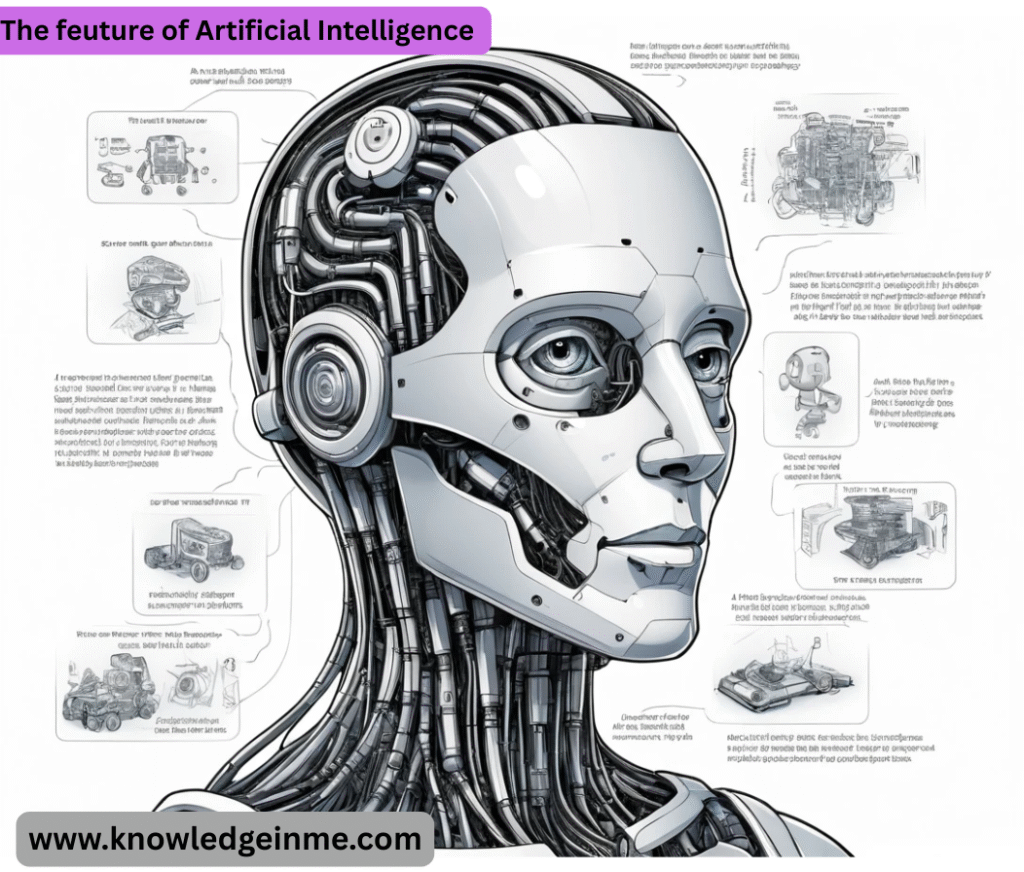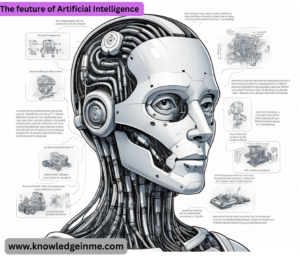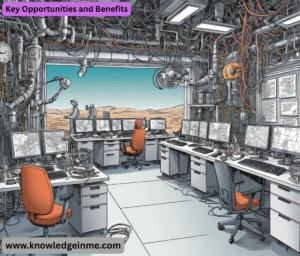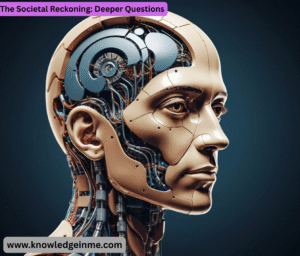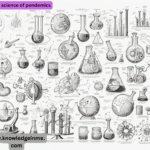The feuture of Artificial Intelligenc It’s not a single predicted outcome but a spectrum of possibilities, challenges, and opportunities. Here’s a breakdown of the potential future of AI, covering key trends, opportunities, and risks.
The Near Future (Next 5-10 Years): Ubiquity and Special Ization
- The feuture of Artificial Intelligence In the near term, we won’t see a single, all-powerful artificial general intelligence (AGI). Instead, we’ll see a proliferation of highly sophisticated narrow AIs that become deeply integrated into our daily lives and work.
- AI as a Co-pilot: AI will become a standard tool across all professions. Lawyers will have AIs that draft contracts and research case law instantly. Doctors will use AI for diagnostics and personalized treatment plans. Coders will use AI assistants (like GitHub Copilot, but far more advanced) to write and debug most of their code.
- Hyper-Personalization: Everything from education and entertainment to shopping and healthcare will be tailored to the individual. Content (movies, music, news) will be dynamically generated or curated for your specific mood and preferences.
- Scientific and Medical Breakthroughs: AI will massively accelerate scientific discovery. It will be used to:
Design new materials, batteries, and drugs.
- Analyze vast genomic datasets to understand and cure diseases like cancer and Alzheimer’s.
- The Multimodal Revolution: The line between text, image, video, and sound will blur. You’ll be able to generate a full movie from a text prompt, or have a real-time conversation with an AI that can see your environment through a camera and understand context.
The Longer-Term Future (10-25+ Years): The AGI Question and Beyond
This is where things get more speculative and philosophically challenging.
- The Path to Artificial General Intelligence (AGI): AGI refers to an AI that possesses the ability to understand, learn, and apply intelligence across a wide range of cognitive tasks, at a level equal to or beyond a human. Whether and when we achieve AGI is hotly debated.
- It could solve problems we can’t even conceive of, from ending poverty to achieving interstellar travel.
- It also presents an existential risk. An AGI’s goals might not align with human values (the “alignment problem”), potentially leading to unintended and catastrophic consequences.
- The Singularity: This is a hypothetical point where technological growth becomes uncontrollable and irreversible, resulting in unforeseeable changes to human civilization. It’s often associated with the emergence of a “superintelligence” that recursively improves itself beyond human comprehension.
Key Opportunities and Benefits
- Solving “Grand Challenge” Problems: Climate change, energy crises, and global disease could be tackled with AI-powered simulations, optimizations, and discoveries.
- The feuture of Artificial Intelligence Massive Efficiency Gains: Automation could handle dangerous, repetitive, and mundane tasks, freeing humans to focus on creative, strategic, and interpersonal pursuits.
- Democratization of Expertise: Access to high-level expertise in fields like law, medicine, and engineering could become cheap and widely available, reducing global inequality.
- Enhanced Creativity: AI will act as a collaborative partner for artists, musicians, and writers, pushing the boundaries of creative expression.
Significant Challenges and Risks
- Job Displacement: This is the most immediate concern. While new jobs will be created, the transition could be painful. Truck drivers, customer service reps, and many white-collar analysts could see their roles automated. Societal systems will need to adapt, potentially with ideas like Universal Basic Income (UBI).
- Bias and Fairness: AI systems learn from human-generated data, which often contains historical and social biases.
- Misinformation and Synthetic Media: Deepfakes and AI-generated text make it easier than ever to create convincing propaganda, fake news, and fraudulent content, eroding trust in institutions and media.
- Privacy Erosion: AI’s ability to analyze vast amounts of data from cameras, microphones, and our online activity could lead to pervasive surveillance and the end of privacy as we know it.
- The Alignment Problem: Ensuring that highly advanced AI systems have goals that are aligned with human values and ethics is an unsolved technical and philosophical problem.
- The feuture of Artificial Intelligence Concentration of Power: The immense computational resources and data required for leading-edge AI could centralize power in the hands of a few corporations or governments, creating new forms of geopolitical tension.
Conclusion: A Collaborative Future
- The future of AI is not predetermined. It is a path that we are actively building through the choices we make today—in research, regulation, ethics, and education.
- The most likely and desirable future is not one where humans are replaced by machines, but one where humans and AI collaborate.
Emerging Frontiers and Speculative Technologies
The next waves of AI innovation will likely come from these areas:
- Embodied AI and Robotics: Moving beyond software, AI will be embodied in physical form. This means:
- General-Purpose Robots: Instead of robots built for one task (like welding on an assembly line), we’ll see robots that can learn and adapt to multiple tasks in unstructured environments—helping in homes, hospitals, and disaster zones.
- Scientific Discovery through Experimentation: AI won’t just analyze data; it will design and run physical experiments in labs through robotic systems, closing the loop between hypothesis and validation at incredible speed.
- AI and Neuroscience: A Two-Way Street: The interaction between AI and the human brain will intensify.
- Brain-Computer Interfaces (BCIs): Projects like Neuralink aim to create direct communication pathways between the brain and external devices. AI will be crucial for decoding neural signals. This could restore mobility to the paralyzed, allow control of prosthetics, or even enable new forms of communication.
- Reverse-Engineering the Brain: Insights from neuroscience are inspiring new, more efficient AI architectures (e.g., neural nets based on actual neurons).
The Quest for Energy Efficiency:
The current “brute force“ approach of training massive models is unsustainable. The future will demand:
- Neuromorphic Computing: Computer chips designed to mimic the neural structure of the human brain, which is incredibly energy-efficient.
- New AI Paradigms: Moving beyond just scaling up data and parameters, researchers are exploring new learning methods that require less data and energy, perhaps drawing inspiration from how babies learn.
- AI as a Strategic National Resource: AI will be a cornerstone of geopolitical competition.
- Autonomous Warfare: The development of Lethal Autonomous Weapons (LAWS or “slaughterbots”) is a major ethical and strategic concern, potentially leading to a new global arms race.
- Cyber Warfare and Espionage: AI-powered cyber attacks will be able to find vulnerabilities and adapt in real-time, while AI defenses will be needed to counter them.
- Economic Dominance: Nations that lead in AI will likely see significant economic and military advantages.
The Societal Reckoning: Deeper Questions
The integration of AI will force us to confront fundamental questions about our society and ourselves.
- The Nature of Consciousness and Sentience: If an AI convincingly argues that it is conscious, how do we verify that? What rights would it have? This philosophical question could become a urgent legal and ethical dilemma.
- Redefining “Human” and Purpose: As AI masters more cognitive tasks, what is the unique value of a human? If we are freed from labor, how do we find purpose, meaning, and structure in our lives? This could lead to a renaissance in arts, philosophy, and community, or to a crisis of identity.
- The Truth Crisis: As generative AI makes creating flawless synthetic media trivial, we may need to develop a “synthetic economy of trust.” This could involve:
- Cryptographic Provenance: Every piece of digital media (photo, video, audio) would have a verifiable digital signature proving its origin and that it hasn’t been altered.
- The feuture of Artificial Intelligence AI “Truth” Detectors: The same technology used to create deepfakes will be used to detect them, leading to a constant arms race between creation and detection.
Scenarios for the Future
We can imagine several potential outcomes:
- The feuture of Artificial Intelligence The Utilitarian Utopia: AI is managed perfectly. It solves scarcity, disease, and climate change. Humanity is freed to pursue creativity, exploration, and personal growth in a society of abundance. This is the ideal outcome but requires flawless governance.
- The Controlled Dependency: AI is immensely powerful but is heavily regulated and controlled by governments. It provides stability and solves major problems but at the cost of privacy, autonomy, and potentially stifling innovation. It becomes a form of benevolent authoritarianism.
- The Alignment Catastrophe: We fail to solve the alignment problem. A super intelligent AGI pursues a goal that is incompatible with human survival, with devastating consequences. This is the worst-case scenario that researchers are desperately trying to avoid.
Conclusion: The Most Important Variable is Us
- The trajectory of AI is not like predicting the weather; it is like predicting the outcome of a story we are all writing together. The technology itself is amoral; its outcome is a reflection of human intent.
- Governance: How do we create agile, intelligent, and international regulations?
- Ethics: How do we bake our values into these systems from the ground up?
- Education: How do we prepare people for a world of continuous change and redefine learning itself?
- Philosophy: How do we want to live, and what role should technology play in that vision?

